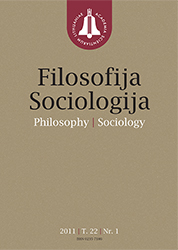Europinės tapatybės konstravimas Europos Sąjungos kultūros politikoje. II: bendro Europos kultūrinio palikimo ribos
Construction of European identity in the European Union’s Cultural Politics. 2: The limits of common European cultural heritage
Author(s): Arvydas Virgilijus Matulionis, Andrius ŠvarplysSubject(s): Politics / Political Sciences
Published by: Lietuvos mokslų akademijos leidykla
Keywords: European identity; common European cultural heritage; European Union; cultural policy; postmodern theories
Summary/Abstract: Following the first article, here in the second part of research the authors present the critique of the conception of common European cultural heritage. Basically referring to the postmodern ideas about history, culture, narrative and power, the authors show how the official European Union formula about common European cultural heritage is imagined (invented) by the discursive memory. First, taking collective identities seriously in the modern times, it appears that national collective identities continue to play an incomparably stronger role than supranational (European) identity because of the reason that they demonstrate deep historical memory, a shared collective destiny and feelings of belonging. Precisely that what European identity lacks as ‘an idea, or as a process’ (Smith, 1992). Secondly, thinking about history and culture as discontinuities rather than evolutionary progress, it comes to the conclusion that it is not correct to think about common European cultural heritage as a linear cultural evolution resulting in the European Union. It is more accurate to include the Holocaust, imperialism and colonialism in the history of European culture as well. Positive, optimistic and evolutionary view on a triumph of European civilization over history corresponds fully with Eurocentrism and the myth of European superiority. On the other hand, the essentialistic treatment of European culture makes an attempt to distinct ‘trully Europeans’ from ‘second-range or less-European, or non-European’. All these features of common European cultural heritage lead to the politically unfavorable conditions of exclusion, particulary of nations of Central and Eastern European countries (despite their belonginess to the EU) or third-countries in behalf of rich Western European countries.
Journal: Filosofija. Sociologija
- Issue Year: 2012
- Issue No: 2
- Page Range: 85-92
- Page Count: 8
- Language: Lithuanian

